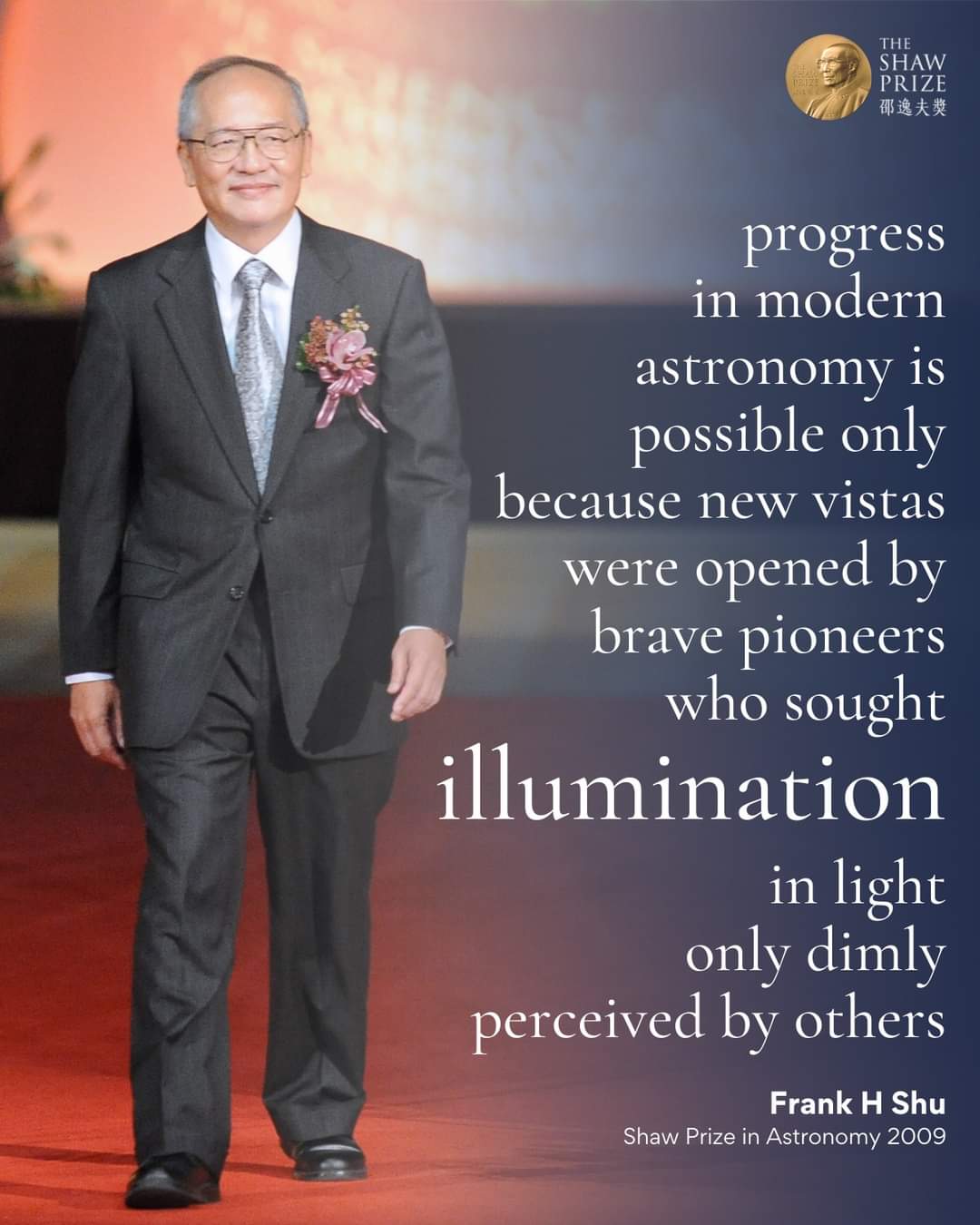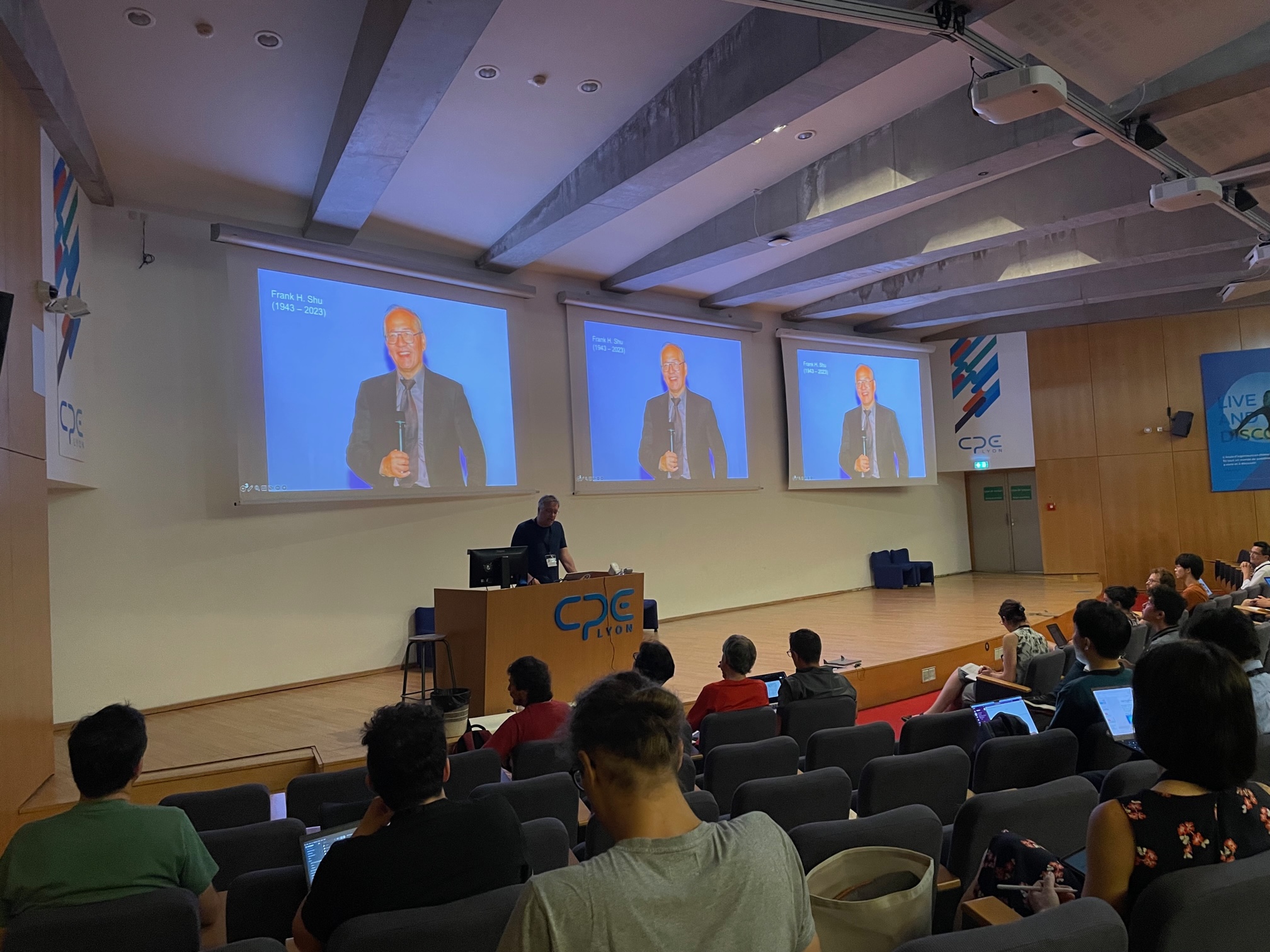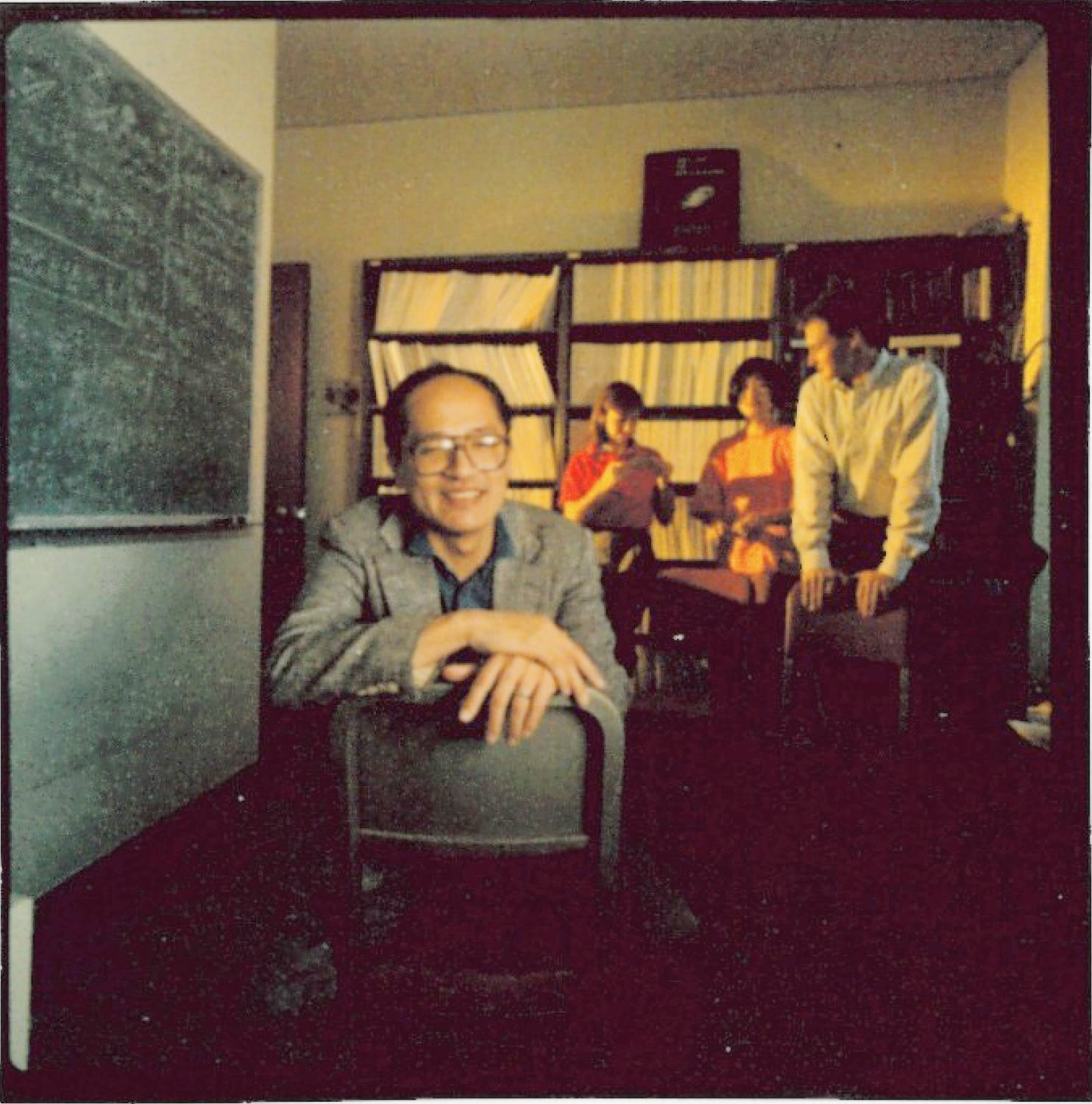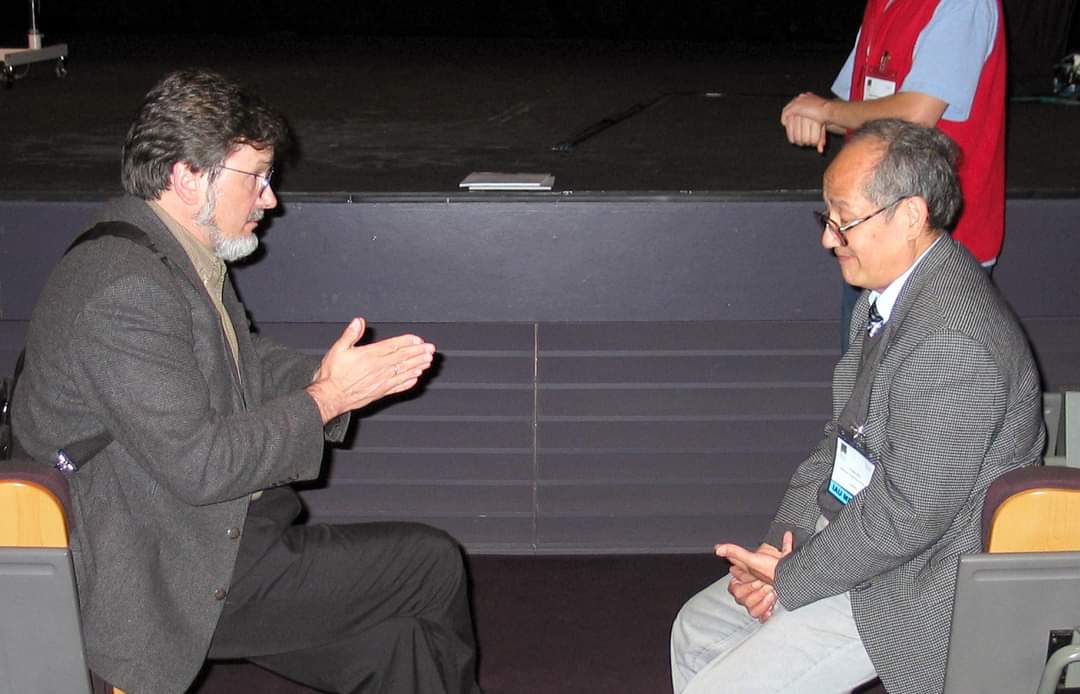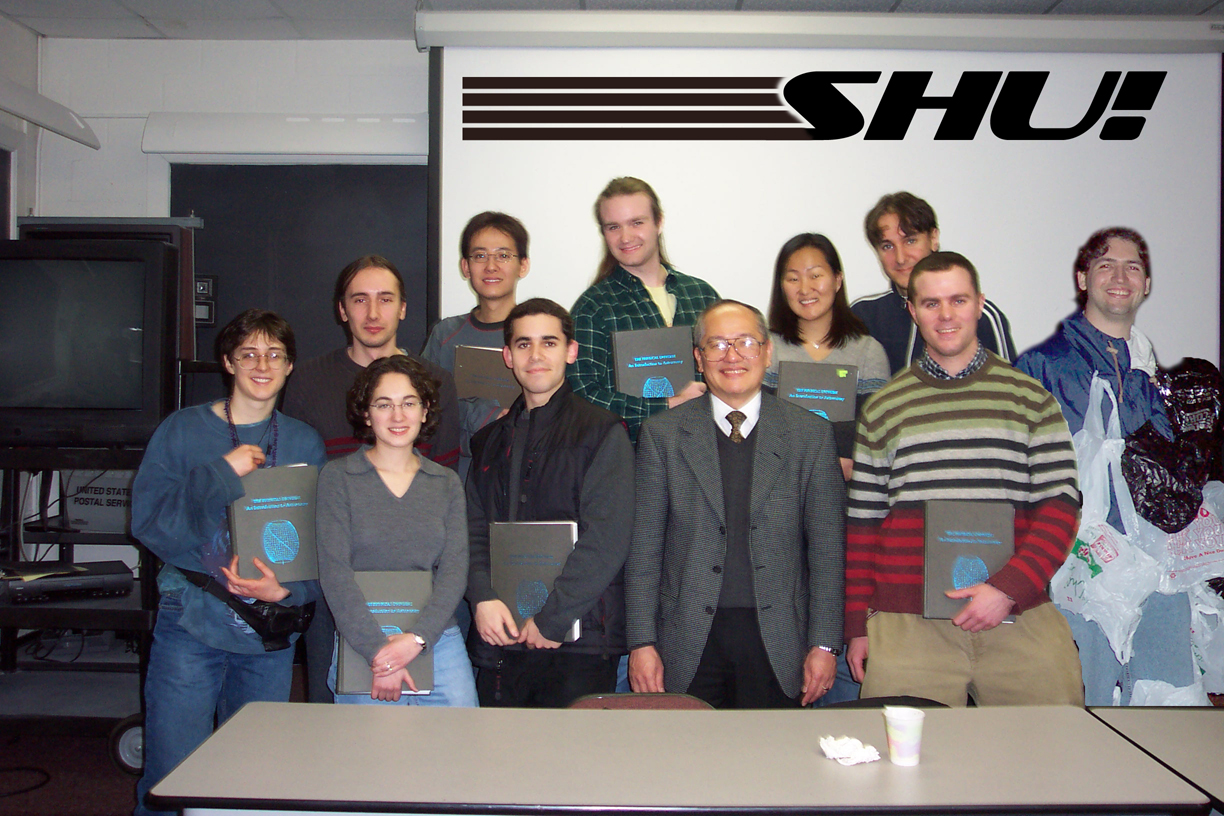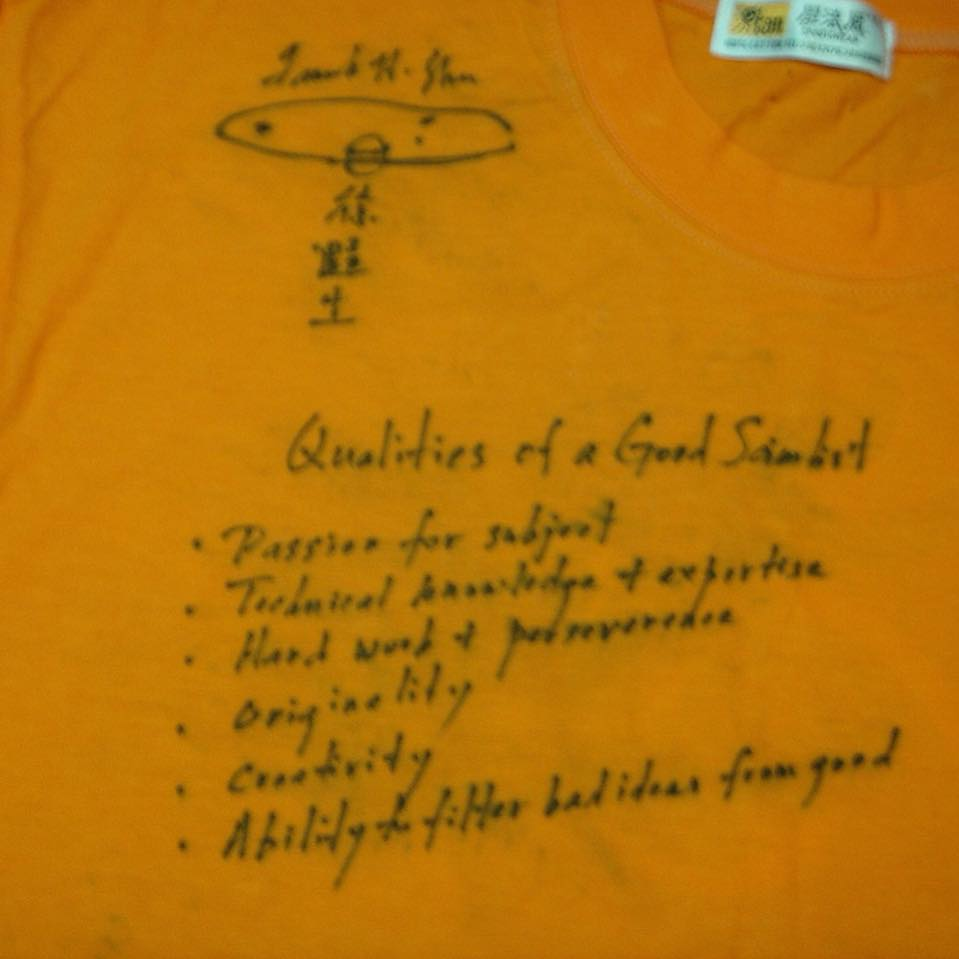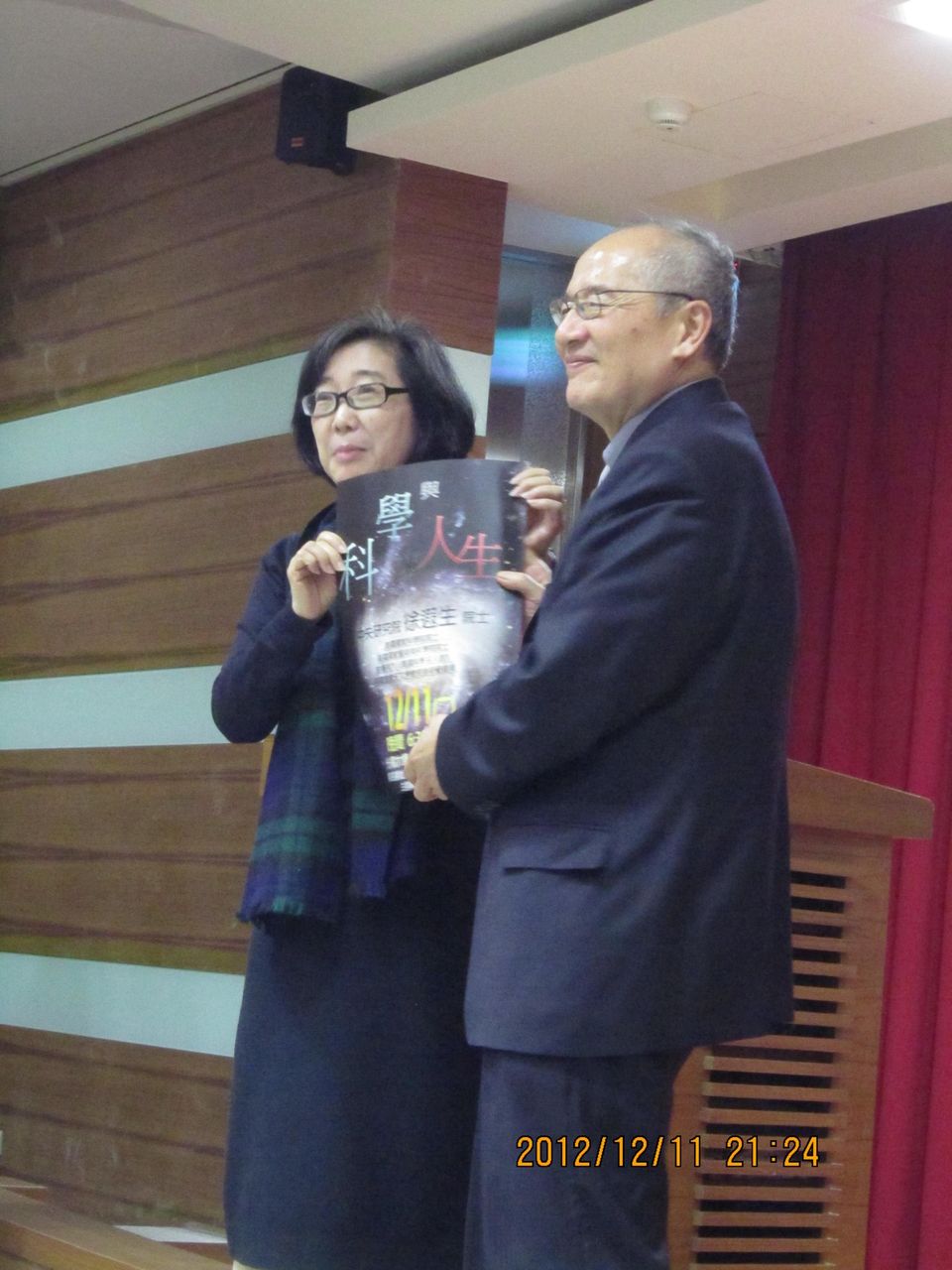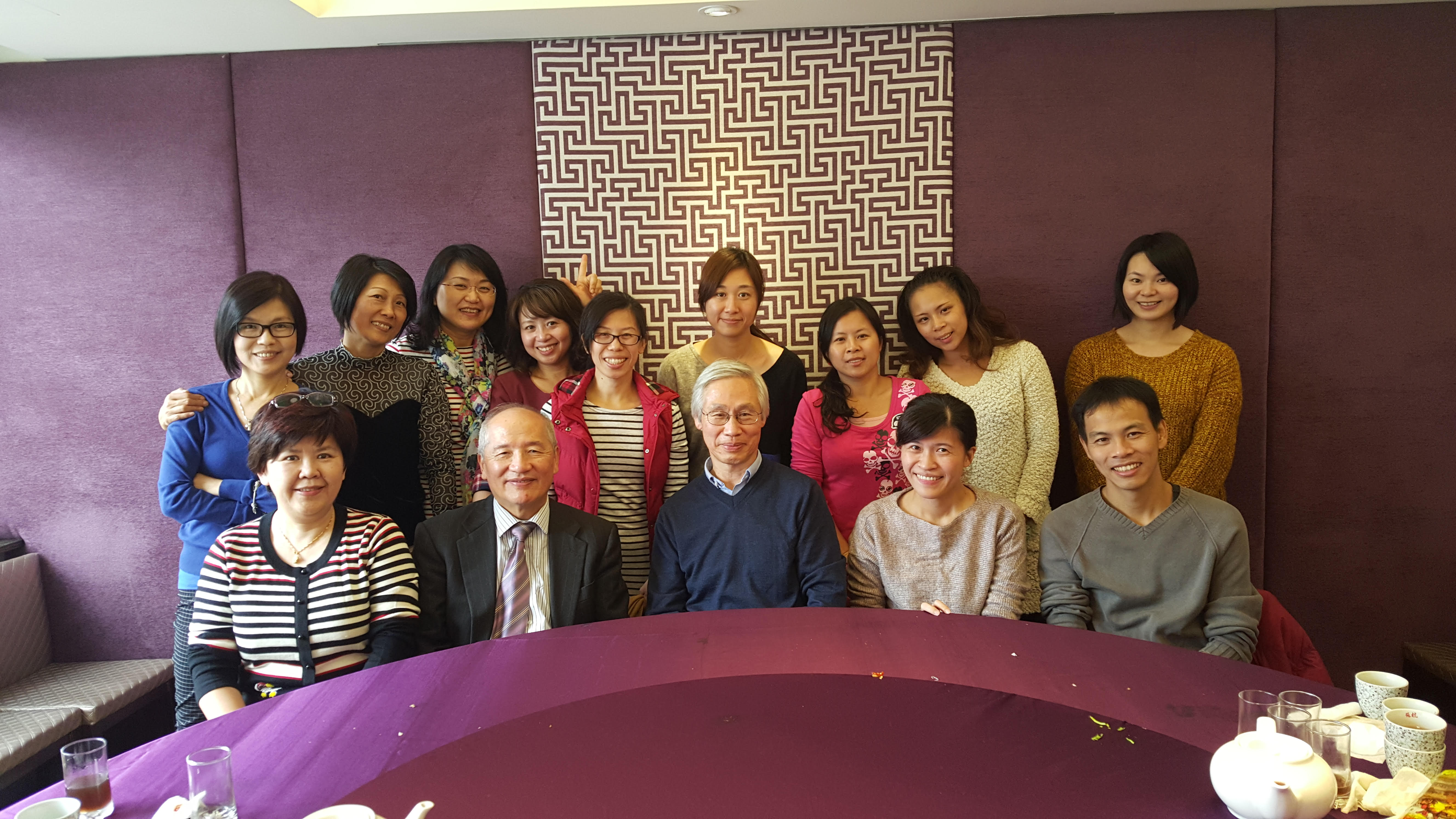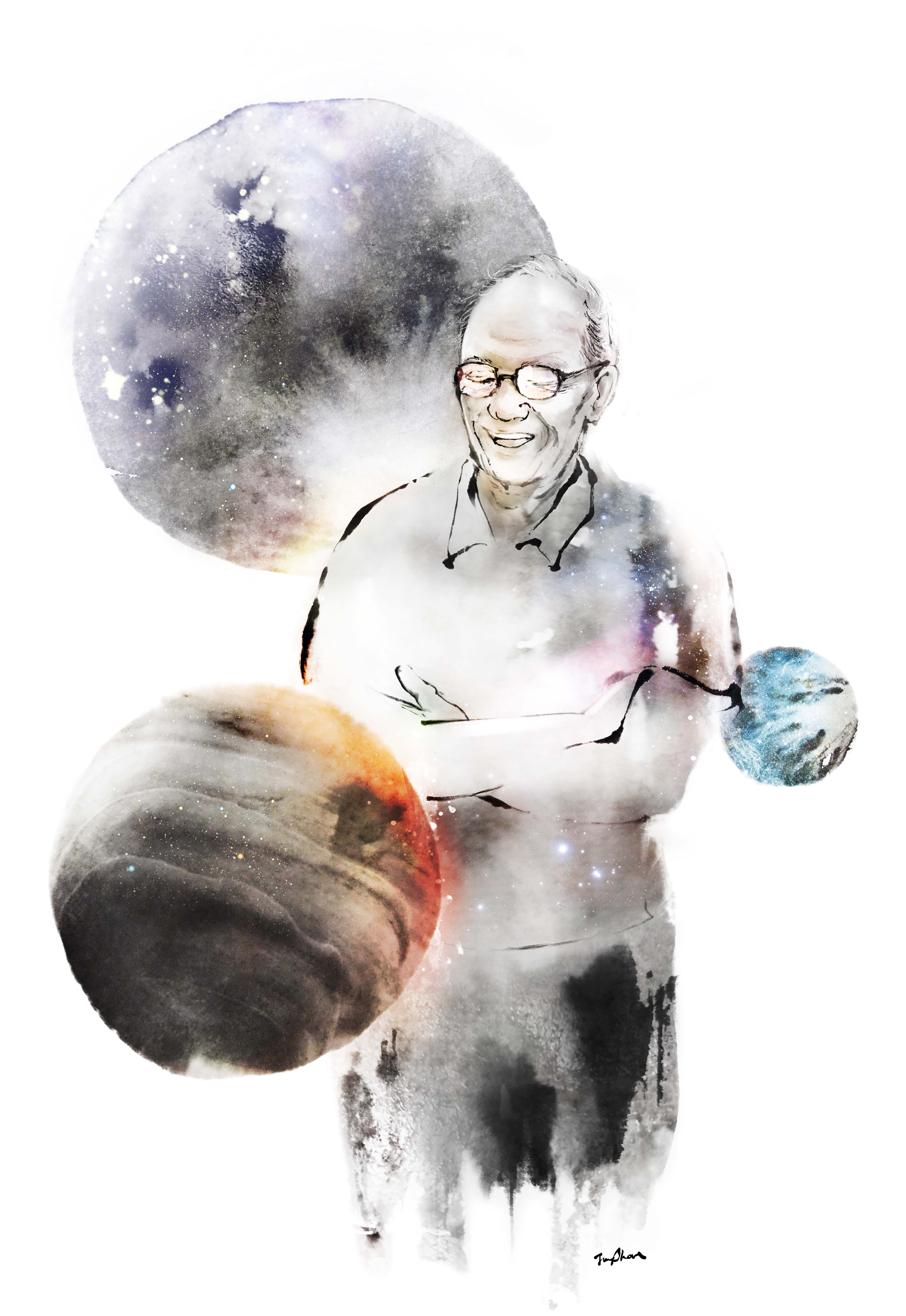June 2, 2023, was Prof. Shu's 80th Birthday
▶ Nature obituary (5 June 2023)
▶ Frank Shu: The forever fighter/PNAS (20 May 2024)

I am deeply saddened to hear about the passing of Frank. Frank was such a visionary scientist and a great educator. Though he has left us, his contributions to science and education will be always remembered by us. I particularly appreciate his leadership role in shaping the development of the Institute of Astronomy and Astrophysics at Academia Sinica and his contributions to the development of molten-salt energy. Dear Frank, our thoughts are always with you and your family.

Time runs fast, and we cannot stop it. For that reason alone, life should be filled with happiness as much as we can. Frank, at the behest of Typhoon, had brought a group of overseas Chinese astronomers to come back to Taiwan to restart astronomical research in a more substantial way. In the 1990’s, astronomy in Taiwan was concentrated at the National Central University, and we were working on how to make the research efforts grow bigger and faster. I remember vividly that after many meetings with senior leaders in science and education in Taiwan, we have been discouraged by the lack of progress. Frank held a meeting with a group of us at the Academia Sinica, and he said we could all return home and continue to write our papers for the next ten years, or we can keep working to see how we can make real changes in Taiwan for the better. It was inspiring and motivating, and classic Frank in vision and purpose. He was talking about impact in our lives. But what he achieved over the last thirty years were the impact on the lives and careers of so many students and so many young people and colleagues, not only in Taiwan but even beyond. I think every moment spent with Frank has always been filled with laughter, happiness, and sense of purpose. His presence will continue in the fabrics of the lives of all those who have had the privilege of meeting and working with him. It has been a very meaningful 30’years.
It has been said that your future is shaped by the people you meet: Frank was definitely a strong influence for me. Initially, it was based on our common scientific interests in stellar astrophysics involving interacting binary star systems, which later evolved to working on the evolution of protostars.
The second phase, lasting greater than a quarter of a century, involved developing astronomy in Asia with an initial goal of establishing a preparatory office in astronomy and astrophysics within Academia Sinica. In so doing, Frank articulated and espoused a vision fostering its development and exploring pathways toward establishing the ASIAA as an institute whose mission was to conduct forefront and fundamental research at the international level. This would lead to the development of the human resources for the future generations of astronomers. Many discussions were held, some behind the scenes, taking place on various occasions over countless meals and venues.
We returned to collaborative research in the most recent decade as Frank shifted his focus to the issue of climate change. In one development, Frank promoted the use of molten salts to torrify biomass into biocarbon products in an oxygen free environment. In another, he developed new ideas for the design of small modular molten salt reactors for clean energy and nuclear waste management.
Throughout our journey in these various phases, I valued Frank’s guidance, advice, insight, and forward thinking which forged our future. He was always generous with his time, and I treasure our years of friendship and collaboration. He is sorely missed, but his spirit will be with us. His memory will guide us as we strive to continue his traditions of excellence in science and work toward the greater good of humanity in climate change mitigation. In humble gratitude, my family and I thank Helen, his esteemed partner and spouse, for sharing him with us.
Many of us are at the Physics of Star Formation conference in Lyon this week. Daniele Galli (also here) mentioned that there will be a memorial for Frank Shu in Taipei tomorrow. We wanted to send you a photo of Frank that was shown in a talk by James di Francesco this morning, reminding us all (160 people are here) of the major contributions of Frank to our field. Please convey our huge appreciation of Frank Shu to the memorial gathering, as we cannot participate in person. Hans and Daniele on behalf of the friends of Frank.
For someone working on fluid dynamics and kinetic theory, Frank's words on the relevancy of mathematical analysis in the understanding of cosmological phenomena are particularly reassuring. I have been impressed by his deep knowledge in mathematics, and have benefited greatly from his explanations of the connection of the study of the Boltzmann equations and dynamics of galaxies.
Frank has such a deep humanity; he would quote Abraham Lincoln in encouraging young people.
Rest well, Frank. You live forever within us.

- photo: Working with Daniele and Frank in TIARA. In the back, two boxes of excellent Chinese tea, a gift from Frank to us.
I had the extraordinary privilege to be one of Frank’s graduate students at UC Berkeley. He was a generous mentor and a good friend. From the beginning, Frank always discussed science with me as if I understood it. It was, of course, an intense training until I finally did understand what he was saying. As much pressure as it was, I know that I was extremely lucky to have him as my mentor. I learned about the problems of star formation at a time when, even though there were a lot of observations, there was no clear theoretical picture of the physical processes that occur during the formation and evolution of young stars. Nevertheless, Frank could see the big picture and understand the physics involved. As Charlie Lada said, he, singlehandedly, established what became the standard paradigm of low mass star formation. This theoretical framework allowed the community to interpret and propose new observations and to advance the field to the richness and level of detail that we know today. I learned about science and scientific research from the intellectual giant that Frank was, and, for that, I will always be truly grateful.
Moreover, Frank was also an exceptional human being. He was extremely generous with his students and collaborators, he shared with us his enthusiasm for science, he taught us by his own example how an ethical scientist behaves. He shared with us the joy of conversation, of good company, and good food. He was concerned about the problems of society, about the role of scientists in the world, what one could do for the benefit of the planet. There was no insurmountable problem for him. He thought he could help change the world and went about doing just that. For me, for many of us who saw ourselves just as simple human beings, the task seemed impossible, but not for Frank. Like a Renaissance man, at the peak of his career in Astronomy, Frank left the field to study and attack problems of nuclear energy production and carbon sequestration, to help ameliorate the problem of global warming.
I will always cherish the many wonderful memories of times working together. For example, the first time we met with Daniele Galli and Al Glassgold at the Osservatorio di Arcetri, we went to dinner one night to eat pizza. This time Daniele lost a battle trying to explain to Frank that, in Italy, unlike in China, pizza is a quantum, it cannot be shared. Frank did not want to hear any of it! In another visit to Taiwan, after Frank showed off the variety of Chinese cuisine, we ended up trying sweet beans. Frank had to concede to me, an expert in chocolate cakes, that the only handicap of Chinese cuisine is that it does not have edible desserts. I also fondly remember our meeting in Tsing Hua University in Taiwan. Frank, who was University President at the time, spared for Daniele and me some of his highly coveted time and we spent several days working together in a huge office in TIARA, with no internet, no books. We were surrounded by blackboards on all walls, full of equations, and Frank was thinking at full speed about the collapse of magnetized cloud cores and protostellar winds. Later in San Diego, we got together again with Al and Daniele to try to solve the full equations of the structure of magnetized protoplanetary disks. We tried several approaches to solve them, but we were stuck, and still, every night Frank had a word of encouragement for the next day’s endeavor. Later, I asked him how could he keep up this positive attitude and he said he did not want us to feel defeated. Those were precious times!
Knowing Frank changed my life. I will miss him deeply.
I still remember the heartbeat of my first meetings with Frank upon my arrival at Berkeley. In front of me, an inexperienced and very confused foreign student, stood this legendary man who had explained the spiral structure of galaxies when he was about my age, quietly expounding his deepest ideas to me as if he were talking to a colleague. I needed a few days of study and a few books to understand the concepts that Frank casually dropped in our conversations (if I can call those early encounters “conversations”). I was intimidated. Local students encouraged me, "Don't be afraid, he’s very nice!" And yes, I soon found out what a nice person Frank was.
Frank's scientific stature is immense, yet when I think to him my memory goes first to his qualities as a human being, to his generosity in the small and big things of life, to his loving concern to the welfare of everyone he was with: I can see him stopping his driver at a shop in Taipei to buy me a full Chinese calligraphy set, knowing my fascination for that art; or filling the kitchen of a house he had rented for me and my family in San Diego with plenty of food (with Helen’s help, I think), so that we didn’t have to worry about groceries when we got there. Small gestures that say a lot about the person.
And, of course, there is Frank the great scientist: from our first meeting to the last email we exchanged, Frank has represented a model, a reference, a unit of measure of the unreachable. Every side-by-side collaboration with him has been an unforgettable experience. On those occasions I understood the meaning of the American expression “drinking from the firehose”. There is only one of Frank’s theories that has always seemed to me plainly wrong: that the Italian cuisine descended from the Chinese, thanks to Marco Polo who had brought Chinese noodles to Italy (the corollary was that also French cuisine descended from the Chinese via the Italian, but I doubt Frank ever dared to expose this theory to his French colleagues).
And there is also Frank the science writer and teacher. Although, after thirty years of use, I have almost destroyed my copies of Frank’s two volume set The Physics of Astrophysics (another gift of Frank, with his handwritten dedication!) I am often surprised to still find in those books a clever explanation unnoticed before, or an original point of view useful for teaching. I bet that no one who has once taken Frank's classes can prepare their own lessons without stopping from time to time to ask themselves “Would Frank teach this in this way? Oh no, let’s start over, and try to do as Frank would do”. How much effort in the mission impossible of conforming to Frank’s standards! But it is also in this effort, that lies the legacy of a great man.
Thank you, Frank.
The world has lost a trailblazing scientist and I have lost an unforgettable friend!
Frank and I first met in the early 90’s when we together tried to help get the astronomy program at Academia Sinica started. We had numerous delicious meals with colleagues from all over the world at Din Tai Fung! Later at the Wu Chien-Shiung Science Camp, his fiery lectures with such deep understanding of the basic sciences and his dedication to inspiring the young minds impressed me so much that I would invite him back whenever he had time, and he did come back many times and we enjoyed every one of them. Then came the molten salt reactor project which led to the successful HX/Super Torrefaction project. Through his innovation, achieving Carbon Negative and collecting Carbon Credits become possible. Over the years, we had many enjoyable discussions together. During the pandemic, we kept contact through emails. In 2021, he wrote to tell me that he '...was writing a two-volume book that the American Institute of Physics (AIP) may publish. The first volume entitled "The Story of Science Seen Through the Lens of Climate Change" is finished and the second volume entitled "The Story of Science Seen Through the Lens of Cosmogony and Cosmology" is 60% finished.' I hope to see those two volumes published soon!
The following is an expanded transcript of remarks from a video tribute that I prepared for Frank’s Memorial held on June 30, 2023.
It is both a privilege and honor for me to be able to participate in this tribute to the life of Frank Shu. I do regret that I cannot be there in person. As you are all are aware, and undoubtedly will hear throughout this day, Frank was a giant figure in astronomy and astrophysics. In particular I can attest that his work with his students in the 70s \& 80s transformed the study of the formation of stars in the universe. He essentially single handedly provided the fundamental framework or skeletal structure upon which our very understanding of the physical process of star formation has been gradually built up over the ensuing decades. More than any one person, Frank’s insights and seminal contributions elevated star formation research from a small niche enterprise to a very prominent level in the scientific community. In doing so he also greatly elevated the significance of the research performed by all of us who worked and continue to work in this field. For that we are all most appreciative.
For me personally Frank was a terrific colleague, mentor, teacher and friend. He had a profound effect on my scientific thinking. Always very encouraging and willing to explain to an observer like myself, the various often difficult aspects, subtleties and complexities of theory in a way that I always walked away feeling that I could understand and grasp the underlying physical significance of whatever scientific issue we were discussing.
I first encountered Frank at a workshop in the Bavarian Alps in 1972. I was a graduate student just starting out on research and Frank a brilliant young professor and one of the invited lecturers at the conference. He was already quite famous because of his thesis work. He spoke about density wave theory and its possible connection to star formatIon. I am sure his talk was great but as a junior participant at the meeting I didn’t get to interact much with lecturers that week. Little did I realize then how significant the intersection of our careers would become and that we would actually work together and even coauthor a couple influential papers on star formation.
I had my first scientific discussions with Frank in 1977 when he came to Harvard to give a colloquium describing his groundbreaking new work on the collapse of the singular isothermal sphere (aka the SIS model) . He had lunch with Bruce Elmegreen and me and among other topics we discussed we looked to see whether there could be any synergy between his new work and the work Bruce and I were doing on sequential star formation. We didn’t find any. But I think I got on Frank’s radar and in the early eighties he became especially interested in the research I was doing on bipolar outflows and, with my student Bruce Wilking, on measuring the spectral appearance of embedded young stars. Frank could foresee the potential for a very direct connection of this research with his ideas of protostellar formation and evolution. With IRAS about to launch, Frank enlisted a brilliant student, Fred Adams, to use the SIS model to predict the infrared spectrum of protostars. Frank was also aware that the observations Bruce and I were obtaining from the ground could be used to test his model. At an extended conference in Santa Barbara we all got together and began a wonderful scientific collaboration.
This led to a sabbatical leave at Berkeley where I got to know Frank and Helen very well and by interacting with him on an almost daily basis I saw first hand how amazing a scientist and person Frank was. For the next two decades I viewed Frank as the singular shinning light that could best illuminate the dark mysteries of stellar origins. When he changed course away from investigating star formation and devoted his efforts to running a major university and to research on nuclear energy I felt it as a great loss for the star formation research enterprise, and it was.
I particularly cherish the extended times I spent with Frank in places such as China, Castel Gandolofo, Berkeley, Santa Barbara and Crete. I would like to relate one particular story about Frank and myself, that was also one of his favorite stories. The story takes place in China in 1993 when Frank, Doug Lin, Bruce Elmegreen, Phil Myers, Paul Ho and I were touring China lecturing at various places in the country. While in Shanghai we were returning from an excursion and Frank asked me to accompany him to a dinner on the other side of the city. It turns out that this was to be a very special dinner because it was a reunion for Frank’s parents and HIS immediate family with their many relatives from all over China. It was in fact the first time his parents had been to China since the war a half a century earlier.
I at first declined this invitation because I felt it would be awkward for me to impose on such a special celebration on such short notice. But Frank insisted I go. So we hailed a cab and off we went. I was a little nervous because I didn’t speak Chinese and we were seemingly heading deep into the depths of this incredibly populous and imposing city. But I trusted Frank would get us to the reunion without a problem. But after a while of driving somewhat erratically, the cab stopped. There was a lively discussion between Frank and the cab driver....as it turns out Frank and the cab drive spoke different dialects of Chinese and they were having difficulty understanding each other and figuring out where to go. I could see the headlines in the morning newspapers: American astronomers mysteriously disappear deep in the black hole of inner Shanghai! But things got resolved and we made to the apartment where Frank’s family was visiting.
The only problem was that, although I was welcome, his father had only arranged transportation to the restaurant for the immediate family and a cousin. So a cab would need to be ordered to get everyone there. I volunteered to go in the cab with Frank’s cousin. But Frank’s father would hear none of that and instead insisted that I accompany him in his car and that it was Frank who should take the cab with his cousin!
On the way to the restaurant Frank’s father regaled me with stories about Frank’s early years. The one story I remember in particular is that when Frank was an undergraduate at MIT his father was concerned about him because Frank seemed to spend more time in the billiard room playing pool than in the classroom! And that explained a lot to me. Now you are all probably aware that Frank was a terrific poker player but he was also an excellent pool player. Now I consistently lost to Frank at both poker and pool but I can say without a doubt that he was a much better pool player than a poker player. Evidently, his time at MIT was really put to good use.
Well back to my story, I arrived at the restaurant with Frank’s parents. Inside there was a big room with many round tables each with seats for about 10 people. In addition on a stage sitting above the rest of the tables was a long rectangular table, the head table, where Frank’s parents and special honored guests were seated. Upon entering the restaurant Frank’s father insisted that I accompany him and sit next to him at the head table. Now I was beginning to truly feel awkward. Shortly thereafter Frank and his cousin arrived and proceeded to sit on one of the round tables on the main floor with everyone else. Feeling very uncomfortable I turned to Frank’s father and said “I see Frank has just arrived and is sitting at a table where he doesn’t seem to know everyone. Perhaps it would be best if I went and sat next to Frank so he would feel more relaxed. Frank’s father agreed and said, “Yes this would be a good idea”.
Not long after I sat at the table next to Frank, his youngest sister approached. She said something in Chinese that caused everyone at the table to look at me and then burst into laughter. Frank then explained to me that his sister was sitting with relatives from western China in another part of the restaurant. Now these relatives had not seen Frank since he was a child. When they watched me arrive with, and then sit next to Frank’s father at the head table they commented to Frank’s sister how astonished they were to see how much Frank had changed since he left China those many years ago.... they speculated that perhaps it was the food!
From that moment on Frank told me that in his family I was known as pseudo Frank.
Going forward Frank will be sorely missed. I know that I miss him very much. But I am also confident that his influence will always remain with those of us who had the distinct privilege to know him.
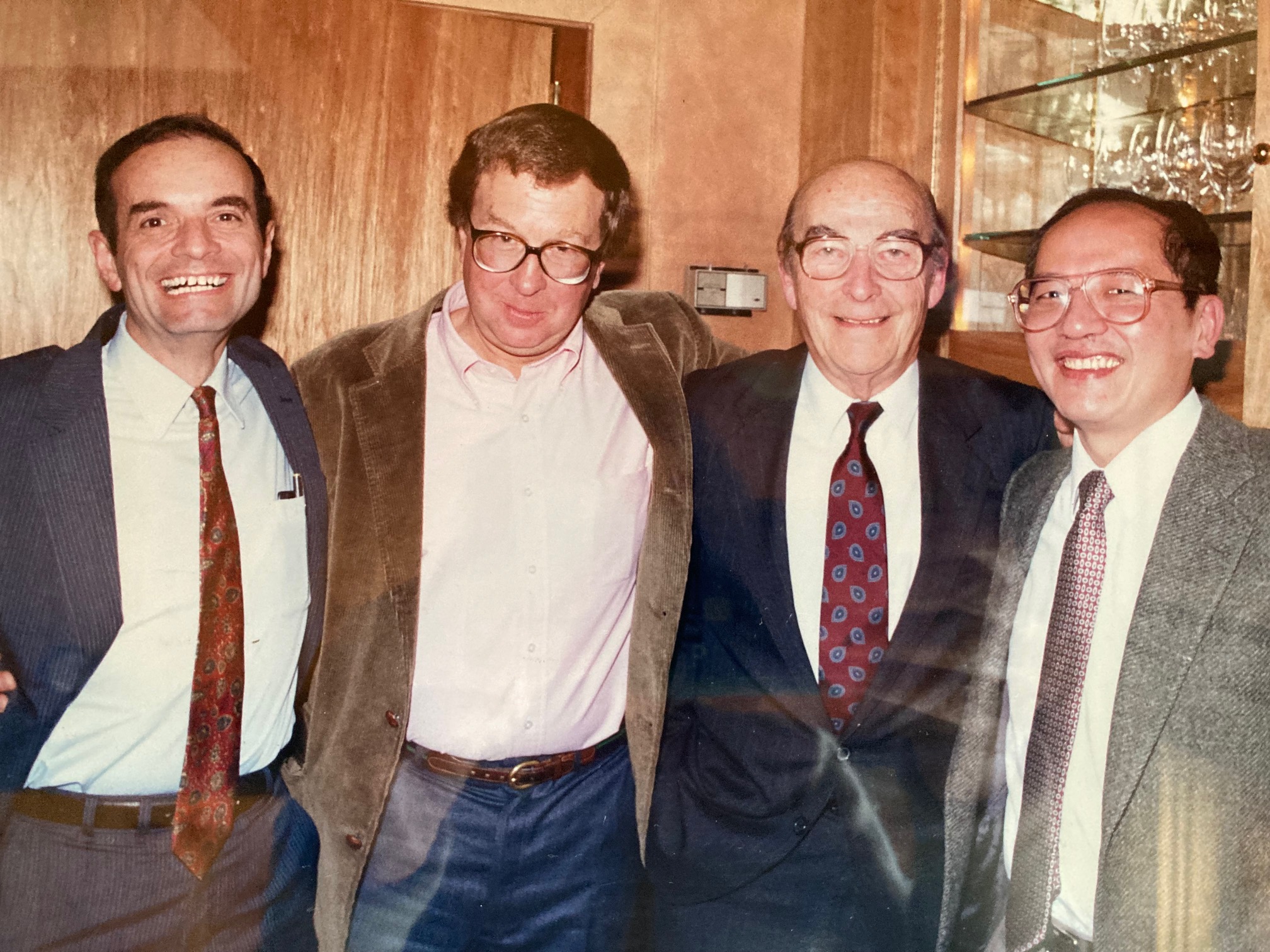
- photo: Frank Shu with Lubert Stryer, Bruce Armbruster, Arthur Kornberg.
Frank and his wonderful wife, Helen, were two of my favorite people. I started University Science Books approximately fifty years ago. We concentrated on publishing chemistry, astronomy and physics books. I soon learned that a very talented faculty member of the Berkeley astronomy department was writing an introduction to astronomy for science students, similar to what Feynman did @ Caltech for physics majors. Frank immediately impressed me as a scientist and a person. Several companies approached him before I did. He asked the McGraw-Hill editor why they wanted to publish his book and Frank was surprised and a little amazed when he replied that they were keen to get someone from a prestigious university like Berkeley into “their stable.” Frank quickly terminated the interview by replying to the McGraw-Hill editor that he had no interest whatsoever in being in “their stable.”
The Physical Universe was one of the most successful books University Books published and Frank was a joy to work with. My friendship with Frank and the publication of his wonderful book was one of the most pleasant and rewarding accomplishments of my fifty plus years in science publishing.
Just remembering Frank’s wonderful laugh brings me great pleasure and joy.
Frank had an enormous impact on our field of star formation, and on me personally. He was uniquely talented in so many ways. I can't think of anyone who comes close to his combination of brilliance, scholarship, charisma, generosity, and fun. He was our Mozart, someone who made magic look easy. One of his favorite sayings was "It's very simple" - and to him, it was.
I had many interactions with Frank over the years, at conferences, visits, at the star formation workshops in Santa Cruz and Berkeley, at meetings in Crete, and during a lecture tour in China. I first learned about Jeans-mass cores, Alfvén-wave line widths, and anisotropic collapse from Frank, in casual conversation. He was a natural explainer, enthusiastic but not pedantic.
He knew a lot and was happy to share. But his global approach was more significant than any single calculation or result. His series of papers on low-mass star formation, written with his students, showed his drive to make our observations understandable from basic physical principles. This work was so inspiring to me because it elevated our field to a higher and more important level. It was as if we observers were mostly picking wildflowers, but he showed how they formed a beautiful bouquet. I am happy that we both had a role in the growing field of low-mass star formation.
We also had a lot of fun playing poker. I learned a lot of new versions and how some of our colleagues were great bluffers and others (like me) usually had no clue. Frank was very welcoming to new players, and there was always a lot of laughter amid the moans and groans.
I'm sad that Frank has left us, but I'm so happy to have known him, to have learned from his work, and from his inspiring example. My condolences to Helen and to their extended family.
Frank Shu was a close colleague, a role model, a l ong-time family friend and a big brother to me. His passing greatly saddened me. To celebrate his life, I have written formal obituaries in both English and Chinese languages, in an attempt to capture his widely acclaimed and admired scientific accomplishments and community contributions. At Sienny Shang’s request, I will indulge here some nostalgic anecdotes over the past half century. Any resemblances between facts and these stories are purely fortuitous.
After the very first lecture I attended as a Part III applied math student in Cambridge in 1971, I was asked by one of my thesis advisors, Douglas Gough, whether I was related to CC. In response to my ignorant "CC who?" question, he retorted "CC Lin, not CC Hu!" and in the same breath, suggested two recently-published papers Frank co-authored with Professors CC Lin and Chi Yuan as my reading assignment. These classics became my introduction to dynamical astronomy.
I finally met Frank in person at a conference in Cambridge during the summer of 1975. He patiently listened to my nervous presentation on the simulation of accretion flow between compact binary stars with a "sticky-particle" code. After my hard sell, Frank made a devastating pronouncement "you should be the first to admit that your attempt of a hydrodynamic simulation is not kosher". After a sleepless night, I was hugely relieved by Frank’s encouraging reconciliation that the concept of my innovative method was "very clever". In the years that followed, whenever I "accused" Frank for his attempt to destroy my confidence and career during our very first meeting, he would reply proudly with a smile "I have succeeded!" A few years later, I accidentally simulated, with the same code, the interaction between a Jupiter-mass companion and the solar nebula. When a spiral pattern shockingly popped up in the printout, I was exuberantly excited and utterly impressed by Frank’s scientific foresights on the density-wave theory.
Over the years, Frank had given me many valuable scientific and crucial career-development advises: to challenge conventional doctrines boldly, to explore innovative ideas passionately, to examine observed data impartially, and to work out technical details meticulously, just to name a few.
When I joined UCSC in 1979 on a meager junior-faculty salary, Frank sagely advised us to work out the maximum budget we could afford and multiply it by two to purchase our first house. He said if we could make it through the first two years, the housing inflation rate would outpace our regular income. I was once again impressed, this time by his financial vision. My family especially appreciated Frank and Helen’s generous and frequent dinner invitations so we could enjoy delicious and sumptuous feasts during the transitional period.
We often went to conferences together. Frank liked to arrive at the airports early and I was the opposite. On a flight to attend the PPII conference, I checked in just 10 minutes before the scheduled departure time. Fortunately, the anxious, arm-waving Frank held the gate open and I even had time for a bathroom relief halfway during my 100-meter dash towards the plane. What a blessing to have such truly caring friend!
On our way back to the Bay Area, Frank had planned to stopover at Las Vegas to attend an AAS annual meeting. His in-flight preaching about the importance of participation in these community forums made me feel rather guilty for not joining him. I was totally relieved to learn afterwards from my student Steve Ruden who participated in the same meeting that Frank had spent most of the meeting breaks and nearly all his sleeping hours, at the poker table. Frank told me later that he was trying to perfect the art of Monte Carlo technique with plastic rather than silicon chips.
Together with John Lattanzio, we went to a 50th anniversary celebration workshop at the MacDonald Observatory. During the long drive through the endless Texas highways, Frank and I exchanged and exhausted all our repertoire of silly jokes, including those from our elementary-school days. At a Texas-style BBQ, Frank proudly boasted the capabilities of his student Fred Adams, especially about the amount of food he was able to consume in one sitting. Not to be outdone by Frank, I wagered him an eating competition between Fred and my former student Artie Hatzes. I was exhilarant that Frank had to concede before Artie even started on his desert.
Frank enthusiastically "inducted" me to my very first poker game after I revealed that I had never played before. Reassured by Frank’s tutorial offer, I took on John Lattanzio over a game of seven-card stud. With 3 kings and 1 queen opened in front of John, 2 aces and 2 jacks showed on my side, John pushed in all his chips to kill. When I innocently asked Frank whether a three-of-a-kind was larger than two pairs, Frank turned his right hand upside down and excitedly exclaimed "Fold! Fold! Fold!". Instead of following his command and to his horror, I throw in all my chips. As John turned over a full house with 3 kings and 2 queens, I glee to show my two pairs of aces. This euphoric beginner’s luck kept us going until 3am. When I gently nudged a snoring Frank during the second presentation the next morning, he briefly mumbled with his eyes still closed "give me three" (new cards).
Frank’s not-so-well-hidden vice was infectious to his colleagues, friends, and students. At the poker table, when the going got tough, he would get going with evolving game rules to alter the strategy and confuse his opponents. When compliments of winning streaks were showered upon him, he would sneeringly respond "not by much" and then redistribute his loots all around the table, especially those who were low on chips. The stakes were miniscule but the relaxation and bonding were immense after long days of heated debates during our monthly Center for Star Formation gatherings.
Frank and Helen were an important part of our family. When we were exploring housing in Palo Alto to enroll our kids into the top high school in the Bay Area, they showed us around. Persuaded by Frank’s irresistible added incentive that we could have poker games every weekend, our family relocated to Palo Alto. Thanks to Frank’s inability to deliver his initial promise, we enjoyed a much more beneficial tennis rendezvous every Saturday instead. On some occasions, Frank would boast about having an undefeated record at the Wimbledon and Flushing Meadows and I would complain most of the tennis balls were on his side of the net! When he drove us to Berkeley I often had to remind him that we only needed to cross the same bridge once over the Bay. In defense, Frank would insist that any lapse in his sense of direction should not hinder his instinct to lead.
Frank and Helen actively participated in many of our family milestone events including our kids’ graduations, university entrance, and weddings. Uncle Frank helped Jane to secure her first summer internship with his architect and generously gave his car to Albert for his high-school graduation. Since the car registration was transferred when we met on a game night, I seized the opportunity to insinuate that I had to drive Frank home because his name was removed from the car’s ownership, due to his poker performance.
Frank had always been charismatic and persuasive. He passionately mobilized several of us to actively engage in elevating astronomy to new heights on the land of our ancestral roots. In his pivotal pep talk to me, Frank followed the legend of a famous Chinese strategist from the three-kingdom era more than a thousand years ago, ZhuGeLiang, by handing me three sealed envelopes with secret recipes for crisis management. These were to be lifesaving straws at times of desperation. Although I never had the need to utilize any of them, my curiosity eventually led to revelation of empty content in the envelopes.
Frank and Helen’s unwavering support was invaluable and endearing on happy occasions and through stressful times. During crises, they were sympathetic, non-judgmental and most helpful. After my quadruple bypass operation, Frank made a special effort to attend my 60th birthday fest in Tuscany despite suffering from bronchitis himself. In his after-dinner speech, he made an heartwarming and memorable "all roads lead to Florence" remark.
I am eternally grateful to Frank’s inspiration, mentorship, and friendship. I will miss him.
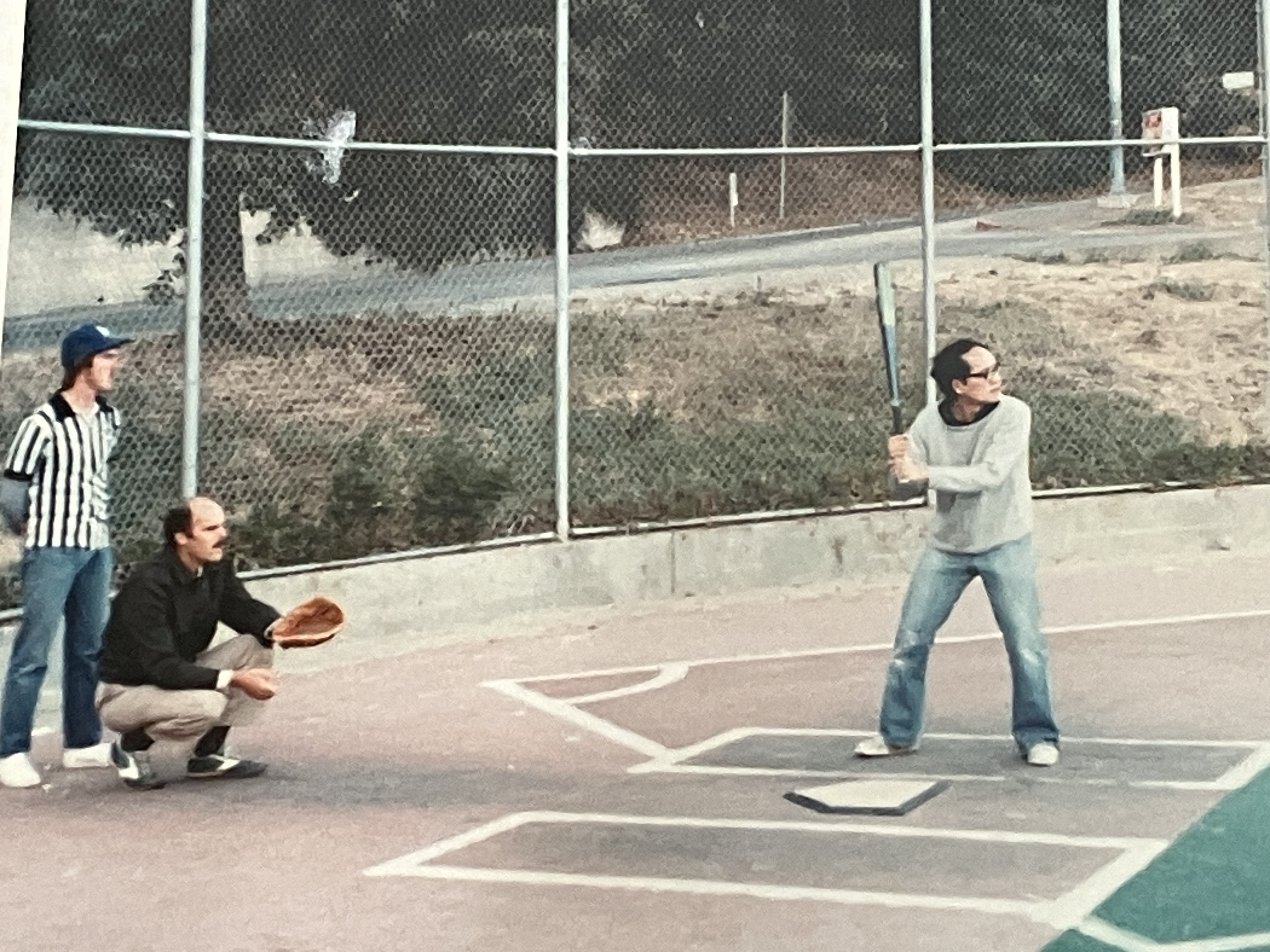
Frank had a profound and positive influence on my career, as he did on the careers of most if not all of his PhD advisees. I have many fond memories of the numerous hours that we spent together in his office, discussing theories, working out calculations on the blackboard, and talking science in general. Sometimes the discussions veered off into other directions, always interesting and occasionally profound.
Frank and I also played softball together for the Berkeley Astronomy Department intramural team, the Spiral Arms. In the picture I took of him batting, you can see how intensely Frank concentrated. He enjoyed playing and was, not surprisingly, quite competitive. One game that we played on astroturf (a hard surface), while running the bases, he made a head-first dive into 3rd base. The next day, when we were meeting in his office, he told me that he was bruised and thought he was too old to play!
Frank sometimes used baseball (and other) analogies in science. It was important to hit singles and doubles to keep in good standing in the profession and to maintain research grant funding, but one is remembered for those few home runs. And to get a home run, the first thing was to choose your pitch (problem to work on), keep your eye on the ball, take a strong swing, connect, and then run around the bases. Frank hit far more home runs (in astronomy) than almost everyone else, and also was a great batting coach.
I was startled and immeasurably saddened by the news of Frank's death. As an undergraduate, I had the privilege of working in his group one summer during the brief period he was at Stony Brook, when he was working on shocks induced by spiral structure. This problem had everything, including shocks in multiphase media, and my job was to develop a 1D kluge for the bowshock formed around a dense cloud plowing through the shocked diffuse ISM. At the end of the summer it became clear that the curvature of the shock could not be neglected, and a full 2D numerical model was developed by Frank and Paul Woodward after Frank moved to Berkeley. I was disappointed, but it was an incredible education and a hinge point in my life. Frank inspired everyone around him, and gift of inspiration extended even to his criticism, which was freely given but so obviously meant in the service of science that it was never personally deflating. Frank's brilliance, insight, and warmth continued to set a standard for me long after that summer. I miss him a lot.
I join everyone in fond memories of Frank and miss him as distinguished astrophysicist, internationalist and friend so true to science and all of us as scientists. I am thinking of my month-long visit, October 2004, at National Tsinghua University as a guest of Frank, University President, and Chou Dean-Yi, Professor of Physics. Frank was terribly busy, and he put away one evening for the two of us to have dinner and talked a good part of the evening. We all will always remember such delightful times with Frank, learning from his deep thoughts on physics, the nature of our scientific work, and people in science and society, and from his diverse personal experiences. Dean-Yi and I had a good time at NTU and I enjoyed visiting the Academia Sinica Institute of Astronomy and Astrophysics where I met the late Fred Lo and Yuan Chi. Lou Yu-Qing, Tsinghua University, Beijing, had a project with Frank and he came to visit him and me. Yu-Qing did his thesis at Harvard with Bob Rosner and was a post-doc with me. In these rapidly changing times, Frank would have reminded us of the value of our scientific contacts and friendship.
I was greatly saddened to hear the news that Frank Shu, one of the greatest theoretical astrophysicists of the 20th century, passed away. He was such a genuine and grounded individual. As an advisee of his colleague Chris Mckee, I had many encounters with Frank during my PhD studies at UC Berkeley. I was Frank's TA for his graduate stellar structure course for one semester, and fondly remember his booming lecture voice, which could be heard clearly across the building. His legacy will still live on through his research, his students, and of course his profoundly insightful textbooks. Just this past semester, I was teaching the Bondi solution in high-energy astrophysics, which is elegantly covered in the second volume of his "Physics of Astrophysics" series. I marveled at how cleverly Frank riffed off of Eugene Parker's classic solar wind argument, going beyond Hermann Bondi's solution to demonstrate that spherical accretion must be supersonic in any realistic astrophysical flow.
I will always remember Frank as one of the most luminous stars at the Center for Star Formation Studies among many brilliant scientists, old and young. Still to this day I remember his kind comments on my first graduate research talk at the Center on star formation in turbulent molecular cloud cores. Academia can be a fiercely competitive environment. From Frank I learned a few thoughtful words can make a huge positive difference on a person’s life, and I do my best to carry that practice forward.
I am deeply saddened by the departure of Frank Shu. I really wanted to see him again! He has been such an inspiration and such a joy to talk to. I will never forget when he came to see my first poster and, after 30 seconds of reading, turned to me and asked: “what’s next?”. Of course, I did not expect this question, so I had to think very fast about my answer. But, I have to say, these words (“what’s next”) have always resonated in my mind and I keep hearing them every time I finish some work. Thank You Frank for all your insight, genius, joy, and friendly smiles.
Frank, I can never thank you enough for the recognition you gave me and the physical insight you instilled in me as a young observational astronomer at a small liberal arts college. I have carried these gifts with me throughout my career, along with fabulous memories of star formation workshops at Santa Cruz, Berkeley, and later Wellesley. I just wish I had had the courage to play poker with you. You are missed.
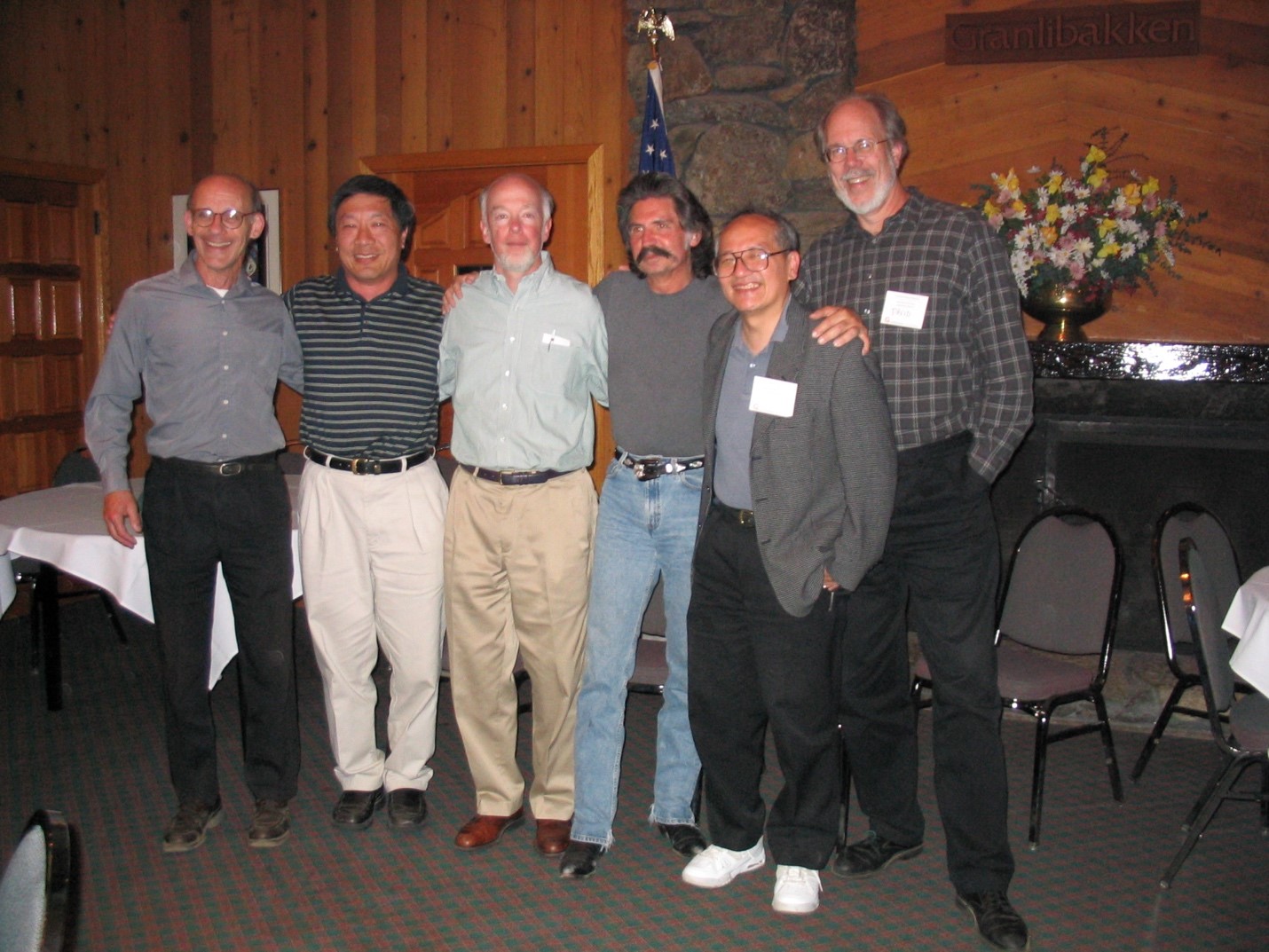
Frank was an essential part of the Center for Star Formation Studies, a consortium of astrophysicists (faculty, students, postdocs) from UC Berkeley, UC Santa Cruz, NASA Ames and Lawrence Livermore Laboratory. It existed from 1985 to about 2003, met almost monthly for all day workshops, and gave many summer weeklong workshops in various locations, including Harvard and Taiwan, but mostly at UC Santa Cruz. Frank contributed greatly to efforts in star formation, disk evolution, and planet formation at the Center, not only through his own work with collaborators, but with his incredibly stimulating comments and suggestions at the workshops. In addition, his humor (often teasing Doug Lin!), organization of poker games and supervision of the food at Chinese restaurants led to highly entertaining and pleasurable sessions. The photo is of the Center Exec Council: Peter Bodenheimer, Doug Lin, Chris McKee, Richard Klein, Frank and me.
I actually met Frank way back in the summer of 1963 at an astronomy summer school at Columbia University for undergraduates, sponsored by NASA and the Goddard Institute there. However, I really got to know him at Berkeley where I had the extreme pleasure of working on a project with Frank, Susana Lizano, and Doug Johnstone. He and I shared an interest not only in astrophysics, but climate change, nuclear power, turning organic waste to char, baseball, poker, and good food. But of course, he was a master in all of these, and taught us all so much. It is a cliché but so true “He will be missed!”
Like several others, I was very fortunate to have been a graduate student for Frank Shu. He had an amazing way of explaining things very clearly. He knew just what the limits were of my knowledge of astronomy as a physics graduate student. Our work together had great influence on how I approached problems throughout my career. He had a way of making progress by analyzing the fundamental elements of a project and making just a few well justified assumptions. This is a challenging way to approach complex issues in astronomy. But Frank was an expert at dealing with such challenges which led him to make major advances in several areas. He had very powerful intuition. He would sometimes correctly guess a result before going through the detailed steps. He was helpful, supportive, and provided very valuable advice throughout my career. I always enjoyed dinner at Frank and Helen's homes. He was a great friend who I will miss.
Frank Shu was a giant in the field of star formation. He had a tremendous impact on the careers beyond those of many students and colleagues, including mine.
Frank Shu has been a great source of inspiration to me in many ways. My introduction to basic astronomy stemmed from his book "Physical Universe," which impressed me by its style, by not catering to the "lowest common denominator" and instead challenging "even the brightest undergraduate students". I have tried to adopt this philosophy in my own teaching. I also used his two books "Physics of Astrophysics" to teach graduate classes. I still remember some of his lectures that I attended, and was impressed by his passion and sense of joy ("the chondrule... gone with the wind".) When I shared my works on the stability of the inside-out solution and the corotation amplifier with him for feedback, he offered detailed comments and encouragement, which meant a great deal to me.
In 2002-2003, I had the opportunity to visit the National Tsing Hua University, where Frank had just become the president and wanted to establish a theoretical astrophysics center. I ended up in a car ride with him from Taipei to Hsinchu one evening, during which we had a conversation that left a strong impression on me. Frank said that the goal of theoretical astrophysics is not to explain all observations, but to gain insight. He gave an example: even if one could create a massive computer simulation that explains every detail of the Crab Nebula's spatial structure and emission, it would not be very useful because little would be learned. This comment has left long-lasting influence on my own research every since.
As a graduate student at the University of California at Berkeley, i was fortunate to be assigned an office next to Frank's corner office. He was not my thesis advisor, but for several years I had more interactions with him than with anyone else on the faculty. When he suddenly had an idea about his research (nearly every day), Frank had the habit to run out to the first available person to bounce it off to see if it made sense. Often, that was me. It didn't matter that I was "only" a grad student. We engaged in conversation about the idea, and he worked out some of the details with me. As a result, some of my first publications were with Frank and his student Steve Lubow (who has also contributed to this memorial). We developed a friendship over those years, and I always felt welcome in his office and home.
I was saddened to learn of Frank Shu's passing. We were dorm mates at MIT where we both participated in a number of activities including card playing and intramural sports. When one of the members of his badminton team became unavailable, Frank took me aside and taught me how to play competitive badminton. And I won my match! Even in badminton, Frank was an excellent teacher. Then I went over to watch Frank's match against a very good player from Indonesia. Frank lost.
I also remember Frank looking forward to the Jewish holiday of Passover. There were a lot of Jewish students in our dorm, so matzoh was available in our dorm's cafeteria during the holiday. It turns out Frank loved matzoh, which he called "matzoh crackers".
Frank was also very bright but in a very congenial way. Most people at MIT were very bright but many were not congenial.
After MIT, I lost touch with Frank, even though we both went to Harvard for our doctorates and earned them in the same year [1968], his in astronomy, mine in chemistry. We did not reconnect until 2013, by which time I had retired and Frank was pursuing research involving molten salt processes for carbon sequestration and nuclear energy. These projects involved a lot of chemistry, so our interests had converged! I served as his unpaid consultant until shortly before Frank's death.
Frank hadn't changed. It was a pleasure working with him. Frank had the rare gift of clarity of thought. He could make difficult concepts understandable.
He will be missed.
Frank Shu recruited me to the faculty at Stony Brook and provided a rock of stability in the early development of the astronomy program there. After I left university life to become an astronomy popularizer, Frank became a supporter of my efforts and went out of his way to smooth my path through life. Like many others, I was always impressed by his knowledge and expertise, which extended to his quest to introduce safe fission reactors to Taiwan. I'm grateful for Frank's friendship and count myself lucky to have known him.
I came to Berkeley in 1994, essentially to embed myself (an observationally oriented postdoc) within the star formation theory group that existed at that time among UCB, NASA/Ames, UCSC, and a few smaller places in the area. Students Eve Ostriker and Joan Najita were finishing or had recently finished their PhDs, and Doug Johnstone and Sienny Shang were still there. Frank was my official postdoctoral advisor. Although we did not interact very much one-to-one, a highlight of my academic existence thusfar was the general environment there -- of spirited and seemingly heated scientific sparring among the theorists and their guests, no matter the audience, but then usually accompanied by good collegial fun and socializing outside of the more serious scientific sessions. It was a special time, and I took it all in.
At one point, I convinced Frank to "front" a Keck observing time proposal for me, because I wanted to try something that such a large telescope could uniquely do (take spectra of embedded protostars). Unfortunately, the TAC was aware that Frank was a professional theorist, rather than an experienced observer, and turned us down. The project eventually got done later when I moved to a different institution.
One of the more admirable Frank Shu quotes, which I think sets him apart from many other theorists (regardless of field of study) goes something like "Let the observers decide if the theory matches the data; the theorist who produced the theory shouldn't decide."
Dear Frank,
It is hard to say goodbye to you. You made a difference to many people, including this young female student. The time was 40 years ago in Berkeley. One thing I remember is sitting in your office, talking about journal articles, talking about science, and being happy. The work we did together was very fine. It was exciting. It mattered. Thank you.
Frank played a huge role in the modern study of star formation. Before his work with Fred Adams, Susan Terebey and others, we had no real theoretical underpinning for our increasingly detailed observations. His models, with clear physical reasoning and testable predictions, provided a shaft of illumination into a dark area. While we know that things are more complex, his models are still relevant (I am running radiative transfer on a TSC model to compare to JWST data right now). But what we remember most about Frank was his enthusiasm, humor, and friendship. He was always ready to make fun of himself, as when he pretended to preach the gospel as the Rev. Sun Moon Shu at a meeting. The memory I like best, however, is Frank peeking at his cards, held close to his chest, as he prepared to relieve Doug Lin of his poker chips.
The first time I met Frank was when I was a postdoc visiting Doug Lin in the Bay area. Doug took me to a dinner where Frank and his wife also attended. I was a bit nervous knowing that I was in conversation with a giant figure in the field. But Frank+his wife and Doug+his wife made the conversations quite cordial and I was struck by the generous spirit Frank showed to a young guy who was trying to figure out the next steps.
In the following years I had more opportunities to interact with Frank and visited Taiwan. I recall that, in one meeting, I was convinced that I have found a new instability in disks associated with vorticity generation and after my talk, Frank took me aside and suggested that I could look up an earlier paper he did on waves in galactic disk dynamics. I was once again in awe how deeply his generation of physicists/astrophysicists have thought through many issues carefully.
Of course what is perhaps most memorable for me was Frank's humor, particularly when he and Doug were in the same room. I remember one event vividly (Sorry Doug, for sharing this story at your expense). I was in Santa Cruz attending one of the Star Formation meetings and Doug first gave a talk. When Frank came up, one light bulb happened to flicker and was about to go out. Frank calmly commented "Doug's idea, just like this bulb, is simply not bright enough."
Like many true giants in the field, one does not need many interactions with them to feel their lasting impact. I am deeply appreciative of how Frank has influenced my own research.
It is very hard to imagine a universe without Frank Shu. He has been such a large presence in my life, as a teacher, a mentor, a role model, and a friend. I am confident that I will continue to consider his reactions to my research with every paper that I write - even though he is no longer near enough to comment directly. In that way, Frank will always be with me!
My first experience with Frank was before I had ever met him, when my undergraduate thesis advisor suggested that we investigate the disk models that Frank and Fred Adams were working on at the time. While this was not the topic that I chose (my first mistake perhaps) I did become aware of the star formation icon at Berkeley and it did influence my desire to go there for graduate school.
My next exposure was in the classroom, taking Frank’s fluid dynamics class and being amazed at the ability to be both detailed and broad picture at the same time. Frank’s love of physics and his keen enjoyment of the puzzling out of nature came through in every lecture. His style resonated extremely well with me at the time, and ever since I find myself teaching with a similar manner. Even if my abilities are only a small shadow of his. I am confident that I have passed on to my own students the same love and fascination with the scientific method, and the exquisite pleasure of finding things out …
A year into my studies at Berkeley I was very much thinking of quitting, as I was not enjoying my interactions with my then thesis advisor. On Scott Tremaine’s advice, I asked Frank to lead me through a directed studies project in the hopes that he would consider me strong enough to take on as a student. Interestingly, the topic we chose at the time to research was planetesimal growth and in the end we mutually decided that it was exciting but that it was not clear where to take it next (it was less than a decade before Frank and his next set of students found this a worthwhile pursuit!). Instead, I was introduced to Dave Hollenbach and with the two of them trying to help me out, I managed a very interesting thesis on disk dispersal.
Throughout my time at Berkeley, Frank was an amazing mentor. I learned to think like a scientist though the many hours that we would spend together discussing my thesis and the larger aspects of star formation within which it lived. Frank was instrumental within the star formation group at Berkeley, Santa Cruz, and NASA Ames - and I was given many opportunities to thrive. I still recall the first invited talk that I gave. Initially it was Frank that was to present the material but he handed the task to me. I began my spiel with a joke, stating that in giving the talk ‘I had a large shoe to fill’ … But in all seriousness, Frank was the consummate advisor: trusting his students, encouraging his students, and building up their strengths. I am very aware that I was incredibly privileged to be part of that group who directly learned from Frank! And again, I hear echos of Frank’s voice and see his actions as I talk with and work with my own graduate students. No day passes where I don’t ask myself - WWFD “what would Frank do?”
Beyond teaching and mentoring, Frank was also a fantastic role model for us all! The entire astronomy community. He remains an icon and his inside-out collapse model is a necessary first step for any aspiring star formation astronomer - theorist or observer! And, it isn’t enough to do the math (recalling that the constant isn’t unity but 0.975!) but one needs to be able to explain in words what is actually going on and why the solution works (not to mention what Frank left out in his simple self-similar power-law solution). Furthermore, Frank showed all of us the importance of leadership - President of the AAS and then President of Tsing Hua university. Perhaps even more influentially, devoting many of his later years to climate change and its mitigation.
Finally, I would be remiss if I did not note that Frank was also a wonderful friend to so many of us. His humour was effusive. I still recall his arguments against Class 0 sources - first there is no 0 in the roman numeral system and second the European zero, with a line through it, also symbolizes the empty set! I remember losing my wallet to Frank and Doug Lin the first night I played poker during a star formation conference and Frank taking me aside, refilling my wallet, and reminding me that to win in poker one must minimize losses and maximize wins. I am convinced that Frank did well in astronomy because he kept that maxim with him at all times, unlike those un-named others at the table that either bluffed consistently or simply played scattershot …
As I said at the opening, I will miss Frank immensely. But, I also know that he will remain with me for the rest of my life - coaching me and making me a better scientist. I will always remember his telling me the story of the Journey West, with the monkey king believing that he was on par with Buddha and being challenged to get off of Buddha’s hand. Suffice to say that the monkey king lost the bet! And Frank, laughing, loved the part where monkey peed on Buddha. This inspired me to read two different copies of the story (kudos to Sienny for helping with both purchases). I don’t think it is hard for any of us to imagine Frank now sitting on Buddha’s hand. But unlike the Monkey King, I don’t imagine a test of wills but rather anticipate an enjoyable repartee of knowledge and wit. However, if they do decide on a challenge I would definitely bet on Frank holding his own.
Thank you to my teacher, my mentor, my role model and my friend!
In Memory of My Dear Friend Frank Shu, Yuk Yung, 17 May 2023
I'm deeply saddened by the recent passing of my dear friend, Frank, at the age of 79. Our paths intersected several times throughout our lives, creating a unique bond between us.
1. A Distinguished Family from Wenzhou
Firstly, Frank and I both have roots in Wenzhou, a city located in China's Zhejiang province, approximately 300 miles south of Shanghai and 200 miles northwest of Taipei. The people of Wenzhou, known as the Wenzhounese, have a long history of emigration, establishing significant communities in many countries, including the United States, Italy, France, Spain, Australia, the Netherlands, Canada, and more recently in Africa.
Renowned for their entrepreneurial spirit, the Wenzhounese have thrived in business, particularly within retail and wholesale trade sectors. In Italy, they've significantly influenced the leather goods and textiles industries. In the United States, they're recognized for their involvement in a variety of businesses, from restaurants to retail shops. Language, a unique aspect of the Wenzhounese diaspora, has helped maintain tight-knit communities overseas. The Wenzhounese dialect, a variant of Wu Chinese, is particularly challenging for non-native speakers, including those from other parts of China.
Although Frank was born in Kunming, Yunnan province, during the War of Resistance against the Japanese, he didn't speak Wenzhounese. His family, however, held a distinguished status in Wenzhou. His grandfather served as acting mayor during the Republic of China (ROC). His father, a renowned scholar and math professor at Purdue University, later became the founding director of Taiwan's famous industrial park, the Hsinchu Science Park. Also known as Taiwan's Silicon Valley, it became a hub for the country's semiconductor and electronics industries, fostering the growth of major companies like TSMC and UMC. Frank, as we'll see, followed closely in his family's footsteps.
2. Academia Sinica Institute of Astronomy and Astrophysics (ASIAA)
During the 1992-1993 academic year, Frank and I both took sabbatical years in Taiwan. Frank focused his efforts on establishing ASIAA, while I assisted the Institute of Earth Science with Global Climate Change. We shared many experiences, from meals at the Academia Sinica Visitor Center's cafeteria to intense ping pong matches in the building's basement. Despite my best efforts, I could rarely best Frank, who was an exceptionally skilled player.
Frank's dedication to creating ASIAA was unparalleled. He tirelessly navigated challenges, negotiating with the President of Academia Sinica, a high-ranking government official, the Chair of the Physics Department at the National Taiwan University (NTU), and the overseas Chinese astronomers. His dedication was most evident in his commitment to teaching an Astronomy course at NTU based on his own classic textbook – and all in Chinese. His lectures, delivered with the precision and skill of a kung-fu master, were a highlight of my sabbatical year.
3. President of Tsinghua University
Frank's appointment as president of Tsinghua University (THU) was hardly surprising, given his father's previous tenure in the same role. I regret never having visited his Taiwan Institute of Advanced Research in Astrophysics (TIARA) during his presidency.
4. Energy
Frank's fascination with the nuclear energy that powers the sun (fusion) and Earth (fission) was palpable. He passionately explored nuclear and solar power as alternatives to fossil fuels. In 2011, I invited him to give a seminar on "Climate Change and Energy Solutions" at Caltech, during which he proposed a myriad of innovative ideas, from nuclear power to bamboo power. His talk was a resounding success, filling the large lecture hall in Cahill (Department of Astronomy) to capacity. As always, his approach was reminiscent of Bruce Lee's: deriving everything from fundamental principles. His lecture (attached) is a treasure trove of innovative ideas on energy.
Frank's vision was to create a Silicon Valley for Energy, a hub that could revolutionize our world's energy needs. The world needs these innovative and forward-thinking ideas more than ever.
Rest in peace, my dear friend! Your visionary contributions to academia and society have left an indelible mark, and you've helped put our beloved hometown of Wenzhou on the map. Your memory will continue to inspire and motivate us all.
I began to know Frank in the beginning of 2005, the 2nd half stint for him as president of Tsing Hua U, working in a very elegant office located at the heart of the campus site, 8F, known as TIARA, acronym for Theoretical Institute for Advanced Research in Astrophysics. Some years passed then he had a group of engineering people working on molten salt technology, also located on Tsing Hua campus, in a tin roof shelter, where he turned himself from a master theoretician to a head of engineers working on a construction site. There are so many stories in those years. One time, when the shooting team from the US was in Taipei on the road to Hsinchu. The molten salts pump was clogged and ceased to operate. We were supposed to do a demo, turning biomass to biochar in 20 minutes. Frank alone figured out the possible cause for the show stopper, the impurities of the industrial-grade salts from overheating. Tashun and Pofu worked around the clock, adding acetic acid little by little. Frank stayed in a Hsinchu hotel with them for several nights. Finally we did the demo successfully for the shooting team just in time. The video link is here. I can still remember the smiles Frank had and all the team members had, smiles in tears. There were other voices saying that we do all over. Against all odds, Frank insisted on staying with the existing salts. God stood on Frank's side. I try to imagine what it was like for Frank, leaving his well-established, world-known astronomy to bio-carbon research. He made a difficult decision, a seldom-trodden road.

我跟徐遐生院士的緣分
Frank Shu 於2023年4月22日逝於美國,他的學術成就,在大學時期就參與優秀的研究,從密度波,恆星形成,到晚期核反應器、碳中和技術,都面對大問題而有傲人成果,這些眾所周知。這裡我只記錄個人的接觸。徐院士比我長15歲,是學術巨擘,感覺上前輩很多,但平常還是以 Frank 稱呼。
跟Frank的第一道緣分是紐約石溪大學 (Stony Brook University),當時全名是紐約州立大學石溪分校。我念博班的時候,就知道他1968年拿到哈佛大學博士後,就去石溪任教,查了網路說直到1973年,而我1983年才去,沒能當成他的學生。
Frank 在 UC Berkeley 時期,帶領一批海外華人天文學家規劃臺灣的天文學發展,從一張白紙開始,仿效美國的「十年規劃白皮書」(decadal planning), 找出課題優先順序,選定電波干涉術切入,這策略非常獨到,因為干涉儀可以逐步增加天線數量,卻大為提高觀測效率,讓臺灣快速進入領域的前沿。這批「顧問」建立了中研院天文所,英文 Academia Sinica Institute of Astronomy and strophysics 縮寫為 ASIAA, 念起來就是 ASIA-A,亞洲第一。我從博班末期開始參與,直到1992年中央大學成立天文所,我有了工作回到臺灣。當時亞洲鄰國都羨慕我們有海外學者,有如此卓越的領域規劃。後來 ASIAA 參與 BIMA、SMA、ALMA 一路下來,奠立了我國天文界在世界的口碑。
很多這些優秀的天文學者不只是 lip service,而有實際貢獻,例如當時已經在國內的 Typhoon Lee(李太楓)大力推動,以及後來中研院歷屆所長 Fred Lo (魯國鏞)、Paul Ho(賀曾樸)、Sun Kwok(郭新)、You-Hua Chu(朱有花),都功不可沒。
我從一個小老弟,站在這些巨人肩上,只怪自己跳不高,終究沒能看得遠。在中央大學跟著同事發展可見光與紅外天文觀測。當時 Frank 等人規劃除了電波天文設備,也「妥協」在鹿林放兩座兩米望遠鏡 Twin Optical Telescopes,一座進行光度測量,另一座取光譜,現在想起來就是 time domain astrophysics 的利基,可惜後來沒有實現。1992年當時中大劉兆漢校長,打電話到美國,跟我說要是我答應協助兩米望遠鏡計畫,他就簽聘書。多年後他在中研院當副院長,找我去院裡演講,開場就說這個故事,說還欠我個兩米望遠鏡。現在耽誤了多年的兩米望遠鏡並非當年那一個,我也從一開始就不贊成,因為深知上鹿林的工程實在艱鉅,直到目前還在找出路。碰到有人問「兩米望遠鏡怎樣了?」,我都說「還是兩米呀!」
我當老師第一年在1993年夏天帶學生去無錫參加恆星形成學校,那是我第一次去大陸,那個從小到大的禁地。那次活動請了很多大咖,把上課內容出書,成了經典教科書。結果學生跟我去程在香港轉機時遇到颱風,在候機室等了兩天。好不容易到了無錫,還沒享受完大師洗禮,就因為有個學生生病,必須立刻回台,除了機位問題,我需要額外現金,結果跟 Frank 「搶劫」了美金300元,算是他演講的代價。
Frank 還在美國的時候(他後來說一共退休了三次),趁來臺灣時我們合開恆星形成的系列課程,他教理論,我講觀測,值得我拿來說嘴。Frank 後來在清大當校長,從一開始有如孩童的中文,到後來可以演講。在我熟悉的恆星誕生領域,他跟博後、學生發展出來的學說成了經典。2008年我請他來所裡演講,他當時關注能源議題,鼓吹安全的核反應器,也思考如何從大氣中回收碳。聽他演講非常享受,除了幽雅英文,還有清晰思路,以一貫天文物理學者的訓練,用第一原理推論風力、水力、潮汐發電的極限,例如地表就這麼多風,這裡風被攔截用來發電,下風處就沒得用。真是做什麼、像什麼,令人佩服。
有次碰到 Frank,他說在這裡當了校長後,終於瞭解了臺灣教授受到的限制,也拍拍我的肩膀說發展自己的設備真的重要。他在美國去世後,我馬上想寫這篇文章,但記得有幾張(跟)他的照片,居然找了幾天沒找到。只有這兩張2012年他來中央大學演講。再來就是2021年,疫情期間我找理由問他核子反應器計畫進行得怎麼樣了,並沒有收到回信。去年審一個學術案子,讀到他寫的推薦信,算是最後聽到他的消息。幾個月前聽說他重病,所以知道哲人遠去,不算意外,但還是唏噓。
Frank一路好走
看到臉友Ken Chen的訊息,知道Frank Shu已經離開,去擁抱他最喜歡的宇宙。 我跟Frank在工研院時互動很多, 他是綠能領域的前指會委員,每半年要對他報告一次。他對我很客氣,意見都從基本物理出發, 很斯文聰明的一個人。
Frank大學部在麻省理工跟林家翹教授(CC Lin)做學士論文,一下子就一炮而紅。那是探討星雲螺旋結構的問題。 他後來的發展我不清楚,但回清大當校長,父子檔都在清華當過校長,一時成為美談。 聽說他不會中文,批閱公文十分不方便,大學校長當一任就不當了。
他在工研院給過一次演講,從物理的角度出發談綠能,結論好像是挺原子能的。只是後來他在清華成立公司,做生質能源,改作化工的工作,後來如何不得而知。
他是個溫文儒雅的學者,意見中肯,有時雖尖銳,但就事論事,挺讓人懷念的。希望他放在俗事,RIP,繼續擁抱星星。
後記: 臉友好奇為何這件新聞小。 我說這世界人來人往,彗星也來來去去,多少人在乎呢? 許多時候,再有名,也沒那麼重要,地球得照轉,太陽得繼續升起。因此。在世間的一天,自己得快活一天,不要太糾結。



